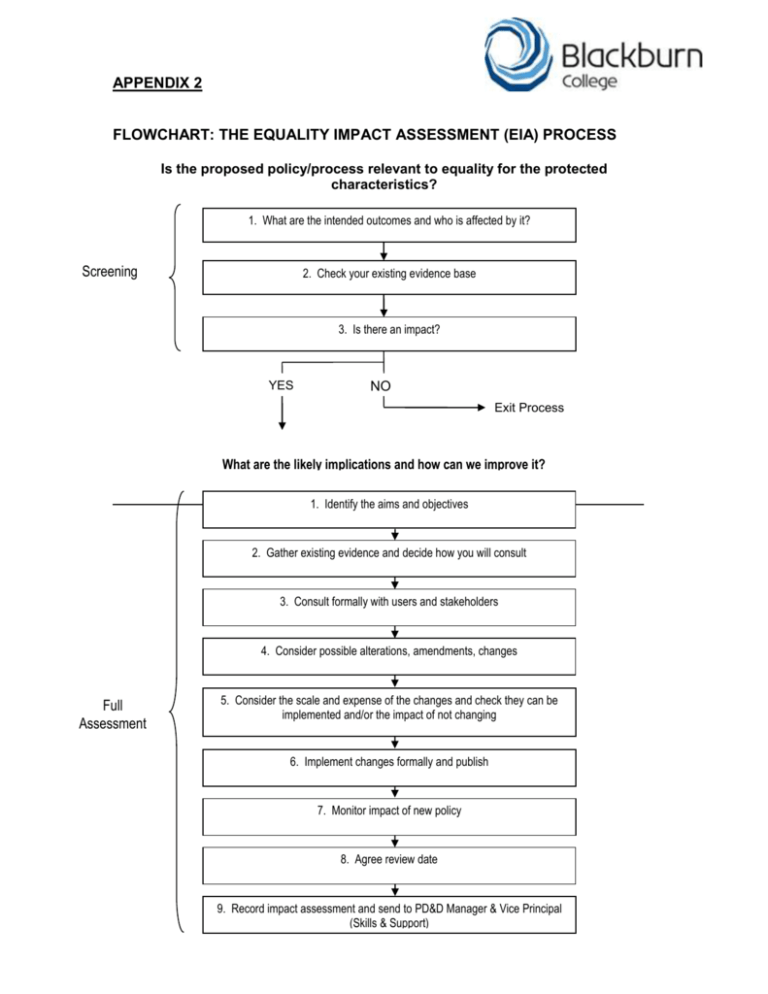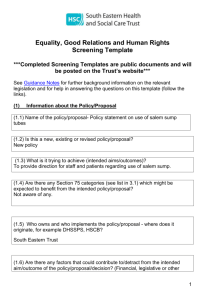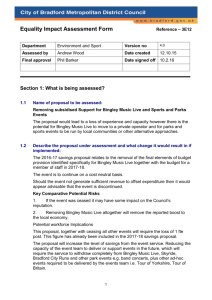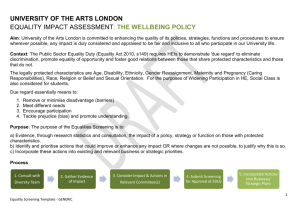toolkit for impact assessment
advertisement

APPENDIX 2 FLOWCHART: THE EQUALITY IMPACT ASSESSMENT (EIA) PROCESS Is the proposed policy/process relevant to equality for the protected characteristics? 1. What are the intended outcomes and who is affected by it? Screening 2. Check your existing evidence base 3. Is there an impact? YES NO Exit Process What are the likely implications and how can we improve it? 1. Identify the aims and objectives 2. Gather existing evidence and decide how you will consult 3. Consult formally with users and stakeholders 4. Consider possible alterations, amendments, changes Full Assessment 5. Consider the scale and expense of the changes and check they can be implemented and/or the impact of not changing 6. Implement changes formally and publish 7. Monitor impact of new policy 8. Agree review date 9. Record impact assessment and send to PD&D Manager & Vice Principal (Skills & Support) TOOLKIT FOR IMPACT ASSESSMENT This toolkit is designed to support you to assess the impact on users of your service, your policies and your procedures. The Equality Act 2010 requires the College to consider how decision making processes may have unintended adverse impacts on particular protected characteristics of learners. It is designed to form the basis of a system that embeds quality considerations throughout policy making and service delivery. The aim is to embed diversity action planning into all our management processes so that each Centre and Service Area creates its own Diversity Plan which sets SMART targets for promoting equality and diversity, minimising unintended barriers to access and stopping all unlawful discrimination. 1. What is an Equality Impact Assessment? It is a process of systematically analysing a proposed or existing policy, process or procedure to identify what effect or likely effect will follow for its implementation and operation. 2. Why do we need to do it? To help us promote a culture of equality and identify possible cases of direct, indirect or institutional discrimination. By fully integrating impact assessment into the review of our policies and procedures and into the Self Assessment process, we should ensure equality of access, treatment and opportunity are fully mainstreamed into our Quality Improvement process. 3. Which parts of the College operations should be assessed? Essentially, all of them. Some services, processes, procedures and policies will, however, have a more significant impact upon users of that service. Some will have a very direct impact of eliminating unlawful discrimination, advancing equality of opportunity and fostering good communications/relations between differing groups of people. Some will not. 4. How do I identify relevance? All policies, process and procedures should be screened in order to consider how it might affect particular groups. Some will have little impact and the impact assessed can be completed in the first stage. Others will require far more detailed assessment. 5. Who is responsible? All managers and team leaders need to reconsider their policies, practices, planning and procedures to ensure they have assessed impact. Where there are recommendations for change, advice may need to be sought from more Senior managers in order to achieve the changes. 6. Who do I do? 6.1 Step one - Screening List your policies, processes, procedures and services Identify their general intended outcomes Outline who is affected by them Identify other key stakeholders (external agencies, other College service areas or Curriculum Centre etc) Consider whether any of them are likely to have an impact on any group of minority users If no impact is likely, the process stops there 6.2 Stage two – Impact Assessment 1. 2. 3. Identify which policies, planning and processes, procedures are in scope (screening) and then prioritise in terms of significance. Use prior consultation, user feedback and quantitative data to help you. (This should be found in your annual self assessment). Select the most important process for your first impact assessment. Identify the specify aims and objectives of the policy or process Review your existing evidence which must include some user feedback with minority groups and will usually include data monitoring information by ethnicity, disability, gender or other group Consider the need for further information. You should, at this stage, demonstrate active involvement with your users and consider how the consultation process can be fully representative of diverse needs. 4. 5. Check throughout this process for: possible adverse effects on minority groups possible barriers to be overcome opportunities to promote disability equality Identify any changes or amendments needed Plan how you will implement these changes within finite resources Change your policy and process within the formal channels of the College Make your users aware of the changes Identify how you will monitor the impact of the changes Record your impact assessment and send to central records Suggestions of evidence to use for impact assessment monitoring Data collection and analysis Surveys, focus groups, one to one or small group consultations Measuring complaints/user satisfaction surveys Observations of process in action Changes to numbers accessing services or processes Physical access and accessibility of information Location/geography Sensitivity to cultural and social differences (differing disabilities, races, faiths) Any restrictive factors (e.g. LSC regulations, funding, other legislation) or reasonable justification for adverse impacts Consider the staff training implications of your impact assessment and plan for this











